Maternal Child Nursing 5th Edition by McKinney Test Bank
Document Content and Description Below
Chapter 01: Foundations of Maternity, Women’s Health, and Child Health Nursing McKinney: Evolve Resources for Maternal-Child Nursing, 5th Edition MULTIPLE CHOICE 1. Which factor significantly contri... buted to the shift from home births to hospital births in the early 20th century? a. Puerperal sepsis was identified as a risk factor in labor and delivery. b. Forceps were developed to facilitate difficult births. c. The importance of early parental-infant contact was identified. d. Technologic developments became available to physicians. ANS: D Technologic developments were available to physicians, not lay midwives. So in-hospital births increased in order to take advantage of these advancements. Puerperal sepsis has been a known problem for generations. In the late 19th century, Semmelweis discovered how it could be prevented with improved hygienic practices. The development of forceps is an example of a technology advance made in the early 20th century but is not the only reason birthplaces moved. Unlike home births, early hospital births hindered bonding between parents and their infants. PTS: 1 DIF: Cognitive Level: Knowledge/Remembering REF: p. 1 OBJ: Integrated Process: Teaching-Learning MSC: Client Needs: Safe and Effective Care Environment 2. Family-centered maternity care developed in response to a. demands by physicians for family involvement in childbirth. b. the Sheppard-Towner Act of 1921. c. parental requests that infants be allowed to remain with them rather than in a nursery. d. changes in pharmacologic management of labor. ANS: C As research began to identify the benefits of early extended parent-infant contact, parents began to insist that the infant remain with them. This gradually developed into the practice of rooming-in and finally to family-centered maternity care. Family-centered care was a request by parents, not physicians. The Sheppard-Towner Act of 1921 provided funds for state-managed programs for mothers and children. The changes in pharmacologic management of labor were not a factor in family-centered maternity care. PTS: 1 DIF: Cognitive Level: Knowledge/Remembering REF: p. 2 OBJ: Integrated Process: Teaching-Learning MSC: Client Needs: Psychosocial Integrity 3. Which setting for childbirth allows the least amount of parent-infant contact? a. Labor/delivery/recovery/postpartum room b. Birth center c. Traditional hospital birth d. Home birth . ANS: C In the traditional hospital setting, the mother may see the infant for only short feeding periods, and the infant is cared for in a separate nursery. The labor/delivery/recovery/postpartum room setting allows increased parent-infant contact. Birth centers are set up to allow an increase in parent-infant contact. Home births allow an increase in parent-infant contact. PTS: 1 DIF: Cognitive Level: Knowledge/Remembering REF: p. 2 OBJ: Nursing Process: Planning MSC: Client Needs: Health Promotion and Maintenance 4. As a result of changes in health care delivery and funding, a current trend seen in the pediatric setting is a. increased hospitalization of children. b. decreased number of children living in poverty. c. an increase in ambulatory care. d. decreased use of managed care. ANS: C One effect of managed care has been that pediatric health care delivery has shifted dramatically from the acute care setting to the ambulatory setting in order to provide more cost-efficient care. The number of hospital beds being used has decreased as more care is given in outpatient settings and in the home. The number of children living in poverty has increased over the past decade. One of the biggest changes in health care has been the growth of managed care. PTS: 1 DIF: Cognitive Level: Knowledge/Remembering REF: p. 5 OBJ: Nursing Process: Planning MSC: Client Needs: Safe and Effective Care Environment 5. The Women, Infants, and Children (WIC) program provides a. well-child examinations for infants and children living at the poverty level. b. immunizations for high-risk infants and children. c. screening for infants with developmental disorders. d. supplemental food supplies to low-income pregnant or breastfeeding women. ANS: D WIC is a federal program that provides supplemental food supplies to low-income women who are pregnant or breastfeeding and to their children until age 5 years. Medicaid’s Early and Periodic Screening, Diagnosis, and Treatment Program provides for well-child examinations and for treatment of any medical problems diagnosed during such checkups. Children in the WIC program are often referred for immunizations, but that is not the primary focus of the program. Public Law 99-457 is part of the Individuals with Disabilities Education Act that provides financial incentives to states to establish comprehensive early intervention services for infants and toddlers with, or at risk for, developmental disabilities. PTS: 1 DIF: Cognitive Level: Comprehension OBJ: Integrated Process: Teaching-Learning MSC: Client Needs: Health Promotion and Maintenance REF: p. 8 6. In most states, adolescents who are not emancipated minors must have the permission of their parents before . a. b. c. d. treatment for drug abuse. treatment for sexually transmitted diseases (STDs). accessing birth control. surgery. ANS: D Minors are not considered capable of giving informed consent, so a surgical procedure would require consent of the parent or guardian. Exceptions exist for obtaining treatment for drug abuse or STDs or for getting birth control in most states. PTS: 1 DIF: Cognitive Level: Knowledge/Remembering REF: p. 17 OBJ: Nursing Process: Planning MSC: Client Needs: Safe and Effective Care Environment 7. The maternity nurse should have a clear understanding of the correct use of a clinical pathway. One characteristic of clinical pathways is that they are developed and implemented by nurses. are used primarily in the pediatric setting. set specific time lines for sequencing interventions. are part of the nursing process. a. b. c. d. ANS: C Clinical pathways are standardized, interdisciplinary plans of care devised for patients with a particular health problem. They are used to identify patient outcomes, specify time lines to achieve those outcomes, direct appropriate interventions and sequencing of interventions, include interventions from a variety of disciplines, promote collaboration, and involve a comprehensive approach to care. They are developed by multiple health care professionals and reflect interdisciplinary care. They can be used in multiple settings and for patients throughout the life span. They are not part of the nursing process but can be used in conjunction with the nursing process to provide care to patients. PTS: 1 DIF: Cognitive Level: Knowledge/Remembering REF: p. 7 OBJ: Nursing Process: Planning MSC: Client Needs: Safe and Effective Care Environment 8. The fastest growing group of homeless people is a. men and women preparing for retirement. b. migrant workers. c. single women and their children. d. intravenous (IV) substance abusers. ANS: C Pregnancy and birth, especially for a teenager, are important contributing factors for becoming homeless. People preparing for retirement, migrant workers, and IV substance abusers are not among the fastest growing groups of homeless people. PTS: 1 DIF: Cognitive Level: Knowledge/Remembering REF: p. 14 OBJ: Nursing Process: Assessment MSC: Client Needs: Physiologic Integrity . 9. A nurse wishes to work to reduce infant mortality in the United States. Which activity would this nurse most likely participate in? Creating pamphlets in several different languages using an interpreter. Assisting women to enroll in Medicaid by their third trimester. Volunteering to provide prenatal care at community centers. Working as an intake counselor at a women’s shelter. a. b. c. d. ANS: C Prenatal care is vital to reducing infant mortality and medical costs. This nurse would most likely participate in community service providing prenatal care outreach activities in community centers, particularly in low-income areas. Pamphlets in other languages, enrolling in Medicaid, and working at a women’s shelter all might impact infant mortality, but the greatest effect would be from assisting women to get consistent prenatal care. PTS: 1 DIF: Cognitive Level: Application/Applying REF: p. 14 OBJ: Nursing Process: Implementation MSC: Client Needs: Health Promotion and Maintenance 10. The intrapartum woman sees no need for a routine admission fetal monitoring strip. If she continues to refuse, what is the first action the nurse should take? a. Consult the family of the woman. b. Notify the provider of the situation. c. Document the woman’s refusal in the nurse’s notes. d. Make a referral to the hospital ethics committee. ANS: B Patients must be allowed to make choices voluntarily without undue influence or coercion from others. The physician, especially if unaware of the patient’s decision, should be notified immediately. Both professionals can work to ensure the mother understands the rationale for the action and the possible consequences of refusal. The woman herself is the decision maker, unless incapacitated. Documentation should occur but is not the first action. This situation does not rise to the level of an ethical issue so there is no reason to call the ethics committee. PTS: 1 DIF: Cognitive Level: Application/Applying REF: p. 18 OBJ: Nursing Process: Implementation MSC: Client Needs: Safe and Effective Care Environment 11. Which statement is true regarding the “quality assurance” or “incident” report? a. The report assures the legal department that no problem exists. b. Reports are a permanent part of the patient’s chart. c. The nurse’s notes should contain, “Incident report filed, and copy placed in chart.” d. This report is a form of documentation of an event that may result in legal action. ANS: D An incident report is used when something occurs that might result in legal action, such as a patient fall or medication error. It warns the legal department that there may be a problem in a particular patient’s care. Incident reports are not part of the patient’s chart; thus the nurses’ notes should not contain any reference to them. PTS: 1 REF: p. 18 DIF: Cognitive Level: Knowledge/Remembering OBJ: Integrated Process: Communication and Documentation . MSC: Client Needs: Safe and Effective Care Environment 12. Elective abortion is considered an ethical issue because a. abortion law is unclear about a woman’s constitutional rights. b. the Supreme Court ruled that life begins at conception. c. a conflict exists between the rights of the woman and the rights of the fetus. d. it requires third-party consent. ANS: C Elective abortion is an ethical dilemma because two opposing courses of action are available. The belief that induced abortion is a private choice is in conflict with the belief that elective pregnancy termination is taking a life. Abortion laws are clear concerning a woman’s constitutional rights. The Supreme Court has not ruled on when life begins. Abortion does not require third-party consent. PTS: 1 DIF: Cognitive Level: Knowledge/Remembering REF: p. 11 OBJ: Integrated Process: Teaching-Learning MSC: Client Needs: Safe and Effective Care Environment 13. Which woman would be most likely to seek prenatal care? a. A 15-year-old who tells her friends, “I don’t believe I’m pregnant.” b. A 20-year-old who is in her first pregnancy and has access to a free prenatal clinic. c. A 28-year-old who is in her second pregnancy and abuses drugs and alcohol. d. A 30-year-old who is in her fifth pregnancy and delivered her last infant at home. ANS: B The patient who acknowledges the pregnancy early, has access to health care, and has no reason to avoid health care is most likely to seek prenatal care. Being in denial about the pregnancy increases the risk of not seeking care. This patient is also 15, and other social factors may discourage her from seeking care as well. Women who abuse substances are less likely to receive prenatal care. Some women see pregnancy and delivery as a natural occurrence and do not seek health care. PTS: 1 DIF: Cognitive Level: Comprehension/Understanding REF: p. 14 OBJ: Nursing Process: Assessment MSC: Client Needs: Health Promotion and Maintenance 14. A woman who delivered her baby 6 hours ago complains of headache and dizziness. The nurse administers an analgesic but does not perform any assessments. The woman then has a tonic-clonic seizure, falls out of bed, and fractures her femur. How would the actions of the nurse be interpreted in relation to standards of care? a. Negligent: the nurse failed to assess the woman for possible complications b. Negligent: because the nurse medicated the woman c. Not negligent: the woman had signed a waiver concerning the use of side rails d. Not negligent: the woman did not inform the nurse of her symptoms as soon as they occurred ANS: A . There are four elements to malpractice, which is negligence in the performance of professional duties: duty, breach of duty, damage, and proximate cause. The nurse was negligent because she or he did not perform any assessments, which is the first step of the nursing process and is a standard of care. By not assessing the patient, the nurse did not meet established standards of care, and thus is guilty of professional negligence, or malpractice. PTS: 1 DIF: Cognitive Level: Knowledge/Remembering REF: p. 16 OBJ: Nursing Process: Evaluation MSC: Client Needs: Safe and Effective Care Environment 15. Which patient situation fails to meet the first requirement of informed consent? a. The patient does not understand the physician’s explanations. b. The physician gives the patient only a partial list of possible side effects and complications. c. The patient is confused and disoriented. d. The patient signs a consent form because her husband tells her to. ANS: C The first requirement of informed consent is that the patient must be competent to make decisions about health care. Full disclosure of information is an important element of the consent, but first the patient has to be competent to sign. Understanding is an important element of the consent, but first the patient has to be competent to sign. Voluntary consent is an important element of the consent, but first the patient has to be competent to sign. PTS: 1 DIF: Cognitive Level: Knowledge/Remembering REF: p. 17 OBJ: Nursing Process: Assessment MSC: Client Needs: Safe and Effective Care Environment 16. Which situation reflects a potential ethical dilemma for the nurse? a. A nurse administers analgesics to a patient with cancer as often as the provider’s order allows. b. A neonatal nurse provides nourishment and care to a newborn who has a defect that is incompatible with life. c. A labor nurse, whose religion opposes abortion, is asked to assist with an elective abortion. d. A postpartum nurse provides information about adoption to a new mother who feels she cannot adequately care for her infant. ANS: C A dilemma exists in this situation because the nurse is being asked to assist with a procedure that she or he believes is morally wrong. The other situations do not contain elements of conflict for the nurse. PTS: 1 DIF: Cognitive Level: Comprehension/Understanding REF: p. 11 OBJ: Nursing Process: Assessment MSC: Client Needs: Safe and Effective Care Environment 17. When planning a parenting class, the nurse should explain that the leading cause of death in children 1 to 4 years of age in the United States is a. premature birth. b. congenital anomalies. . c. accidental death. d. respiratory tract illness. ANS: C Although the rates have dropped, unintentional injury (accidents) are still the leading cause of death for children aged 1 to 19. The other options contribute to morbidity and mortality in children but are not the leading cause. PTS: 1 DIF: Cognitive Level: Knowledge/Remembering REF: p. 10 | Table 1.3 OBJ: Integrated Process: Teaching-Learning MSC: Client Needs: Safe and Effective Care Environment 18. A nurse is floated to a different unit. The nurse does not know how to perform a treatment that has been prescribed for one of his or her assigned patients. What should the nurse’s first action be? a. Delay the treatment until another nurse can do it. b. Make the child’s parents aware of the situation. c. Inform the nursing supervisor of the problem. d. Arrange to have the child transferred to another unit. ANS: C Nurses who work outside their usual areas of expertise must assess their own skills and avoid performing tasks or taking on responsibilities in areas in which they are not competent. This nurse should inform the supervisor of the situation. The nurse could endanger the child by delaying the intervention until another nurse is available. Telling the child’s parents would most likely increase their anxiety and will not resolve the difficulty. Transfer to another unit delays needed treatment and would create unnecessary disruption for the child and family. PTS: 1 DIF: Cognitive Level: Application/Applying REF: p. 19 OBJ: Nursing Process: Implementation MSC: Client Needs: Safe and Effective Care Environment 19. The mother of a 5-year-old female inpatient on the pediatric unit asks the nurse if she could provide information regarding the recommended amount of television viewing time for her daughter. The nurse responds that the appropriate amount of time a child should be watching television is a. 1 to 2 hours per day. b. 2 to 3 hours per day. c. 3 to 4 hours per day. d. 4 hours or more. ANS: A The American Academy of Pediatrics (2013) encourages parents to monitor their children’s media exposure and limit their children’s screen time (TV, computer, video games) to no more than 1 to 2 hours per day. The other options all contain more screen time than is recommended. PTS: 1 DIF: Cognitive Level: Comprehension/Understanding REF: p. 15 OBJ: Integrated Process: Teaching-Learning MSC: Client Needs: Health Promotion and Maintenance . 20. Family-centered care (FCC) describes safe, quality care that recognizes and adapts to both the physical and psychosocial needs of the family. Which nursing practice coincides with the principles of FCC? a. The newborn is returned to the nursery at night so that the mother can receive adequate rest before discharge. b. The father is encouraged to go home after the baby is delivered. c. All patients are routinely placed on the fetal monitor. d. The nurse’s assignment includes both mom and baby and increases the nurse’s responsibility for education. ANS: D Family-centered care increases the responsibilities of nurses. In addition to the physical care provided, nurses assume a major role in teaching, counseling, and supporting families. The other options do not provide family-centered care because they increase family separation or use technology routinely, which may not be needed. PTS: 1 DIF: Cognitive Level: Comprehension/Understanding REF: p. 2 OBJ: Integrated Process: Caring MSC: Client Needs: Health Promotion and Maintenance 21. Which statement related to nursing care of the child at home is most correct? a. The technology-dependent infant can safely be cared for at home. b. Home care increases readmissions to the hospital for a child with chronic conditions. c. There is increased stress for the family when a sick child is being cared for at home. d. The family of the child with a chronic condition is likely to be separated from their support system if the child is cared for at home. ANS: A Greater numbers of technology-dependent infants and children are now cared for at home. The numbers include those needing ventilator assistance, total parenteral nutrition, IV medications, apnea monitoring, and other device-assisted nursing care. Optimal home care can reduce the rate of readmission to the hospital for children with chronic conditions. Consumers often prefer home care because of the decreased stress on the family when the patient is able to r... [Show More]
Last updated: 1 month ago
Preview 1 out of 609 pages

Reviews( 1 )

by amichie5 · 3 years ago
great
Recommended For You
*NURSING> TEST BANK > Test Bank For Neeb's Mental Health Nursing 5th Edition by Linda M. Gorman, Robynn Anwar Chapter 1-22 (All)

Test Bank For Neeb's Mental Health Nursing 5th Edition by Linda M. Gorman, Robynn Anwar Chapter 1-22
Test Bank For Neeb's Mental Health Nursing Linda M. Gorman, Robynn Anwar Chapter 1-22 Test Bank For Neeb's Mental Health Nursing Linda M. Gorman, Robynn Anwar Chapter 1-22Test Bank For Neeb's Mental H...
By QUIZBANK , Uploaded: Jun 20, 2022
$19
PSYCHIATRIC MENTAL HEALTH NURSING> TEST BANK > Test Bank - Introductory Mental Health Nursing 5th Edition by Cynthia Kincheloe - Complete Elaborated and Latest Test Bank. ALL Chapters(1-19)Included and Updated (All)
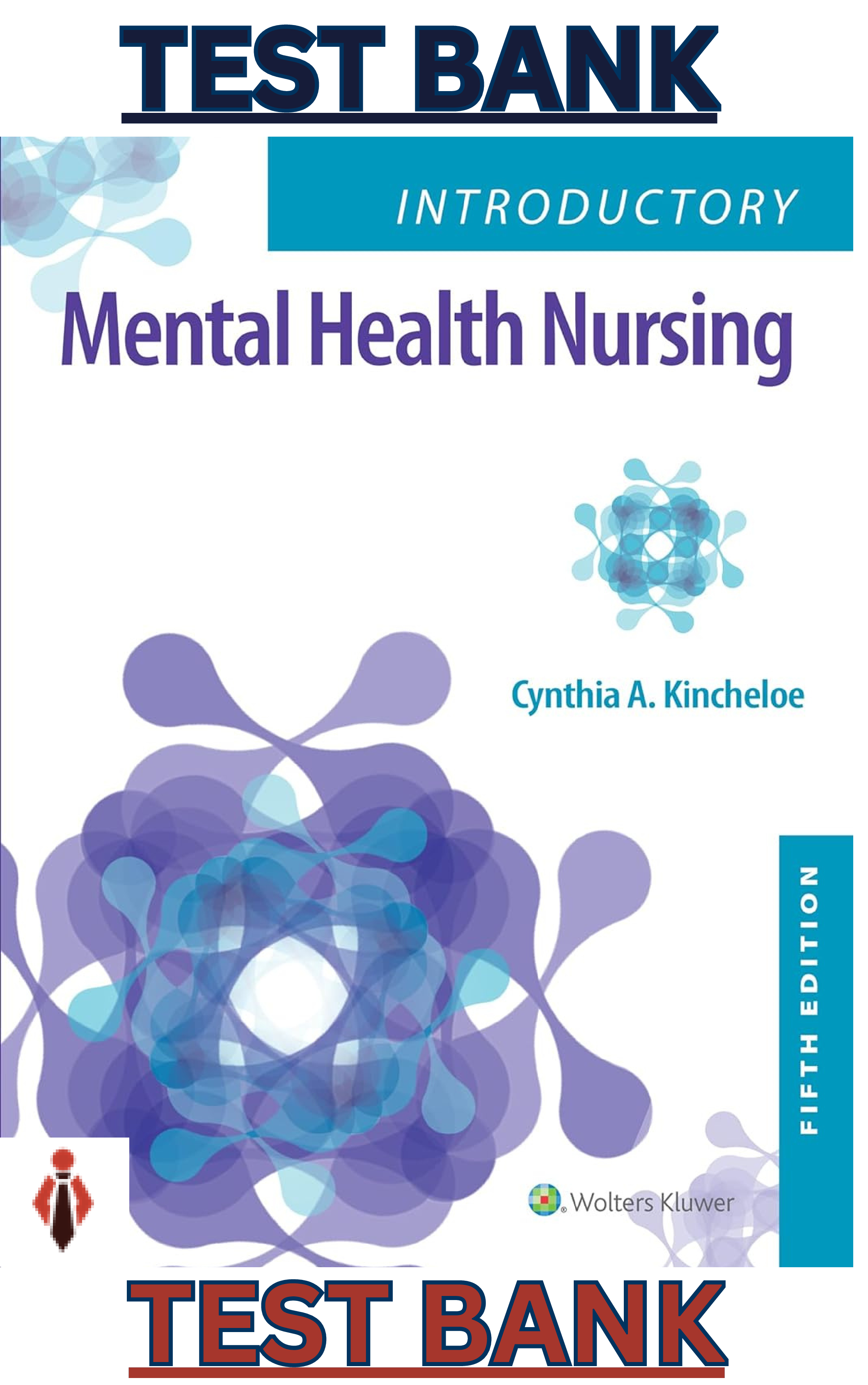
Test Bank - Introductory Mental Health Nursing 5th Edition by Cynthia Kincheloe - Complete Elaborated and Latest Test Bank. ALL Chapters(1-19)Included and Updated
Test Bank - Introductory Mental Health Nursing 5th Edition by Cynthia Kincheloe - ISBN10: 1975211243 | ISBN13: 978-1975211240 Test Bank - Introductory Mental Health Nursing 5th Edition by Cynthia Ki...
By Prof.Exams , Uploaded: Mar 31, 2024
$21
PSYCHIATRIC MENTAL HEALTH NURSING> TEST BANK > Test Bank - Introductory Mental Health Nursing 5th Edition by Cynthia Kincheloe - Complete Elaborated and Latest Test Bank. ALL Chapters(1-19)Included and Updated (All)
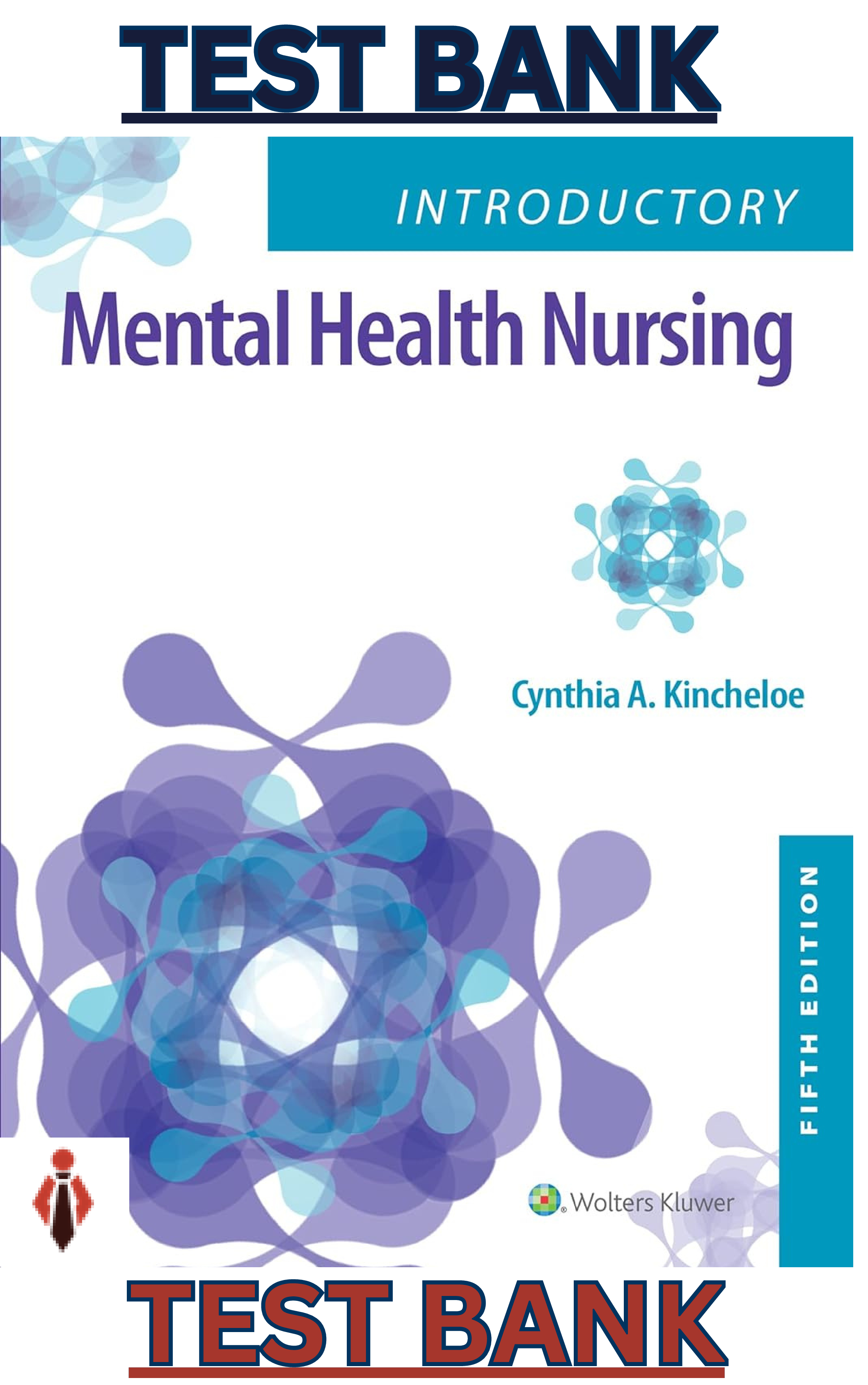
Test Bank - Introductory Mental Health Nursing 5th Edition by Cynthia Kincheloe - Complete Elaborated and Latest Test Bank. ALL Chapters(1-19)Included and Updated
Test Bank - Introductory Mental Health Nursing 5th Edition by Cynthia Kincheloe - ISBN10: 1975211243 | ISBN13: 978-1975211240 Test Bank - Introductory Mental Health Nursing 5th Edition by Cynthia Ki...
By ProfXams , Uploaded: Mar 31, 2024
$21
*NURSING> TEST BANK > TEST BANK for Medical-Surgical Nursing 5th Edition by Holly Stromberg. All Chapters 1-49. (All)
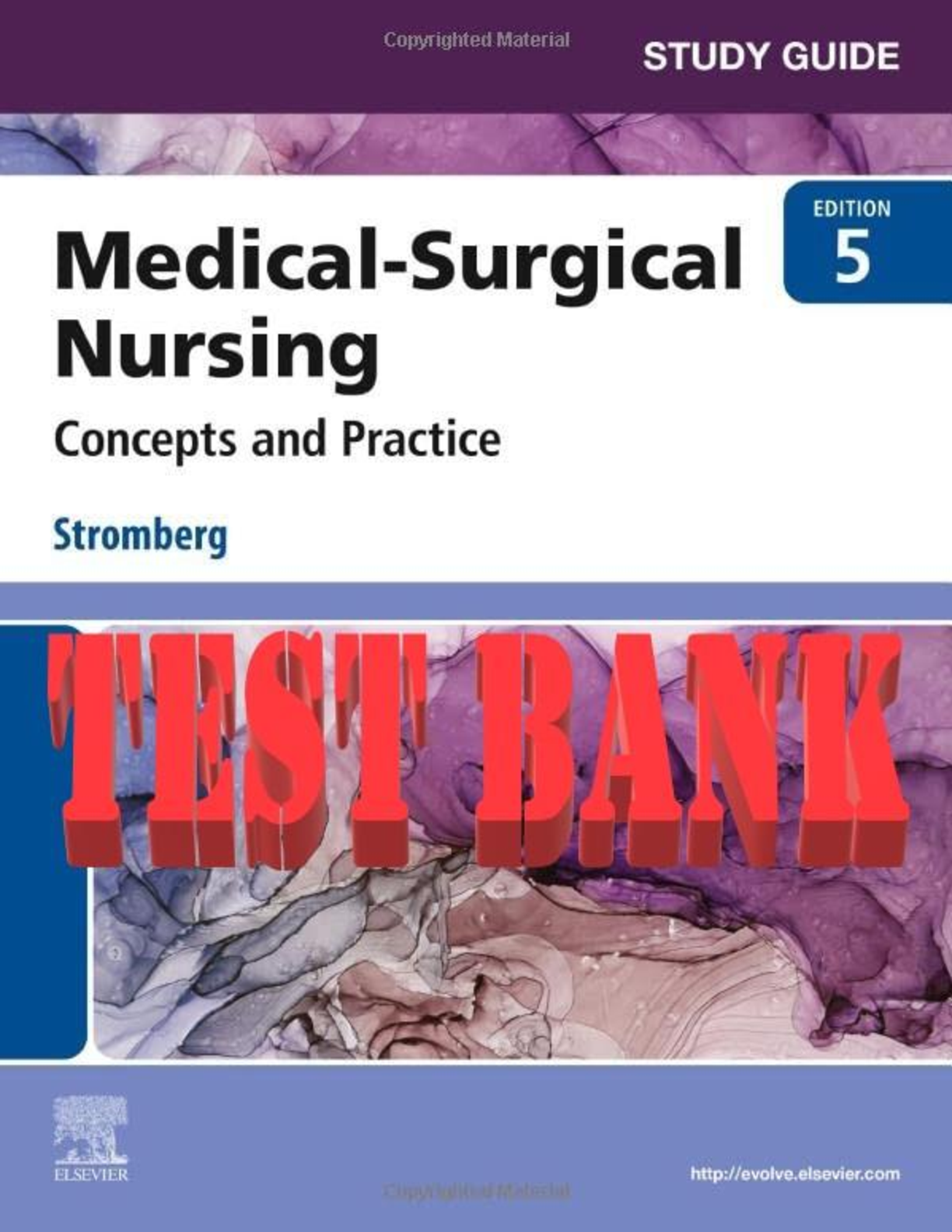
TEST BANK for Medical-Surgical Nursing 5th Edition by Holly Stromberg. All Chapters 1-49.
Medical-Surgical Nursing 5th Edition by Holly Stromberg RN, BSN, MSN, PHN, Alumnus CCRN. ISBN-10 0323810217 ISBN-13 978-0323810210. All Chapters 1-49. 821 Pages. TEST BANK.
By QuizMaster , Uploaded: Nov 11, 2020
$22
*NURSING> TEST BANK > Test Bank for Canadian Nursing 5th Edition Ross-Kerr All Chapters (All)
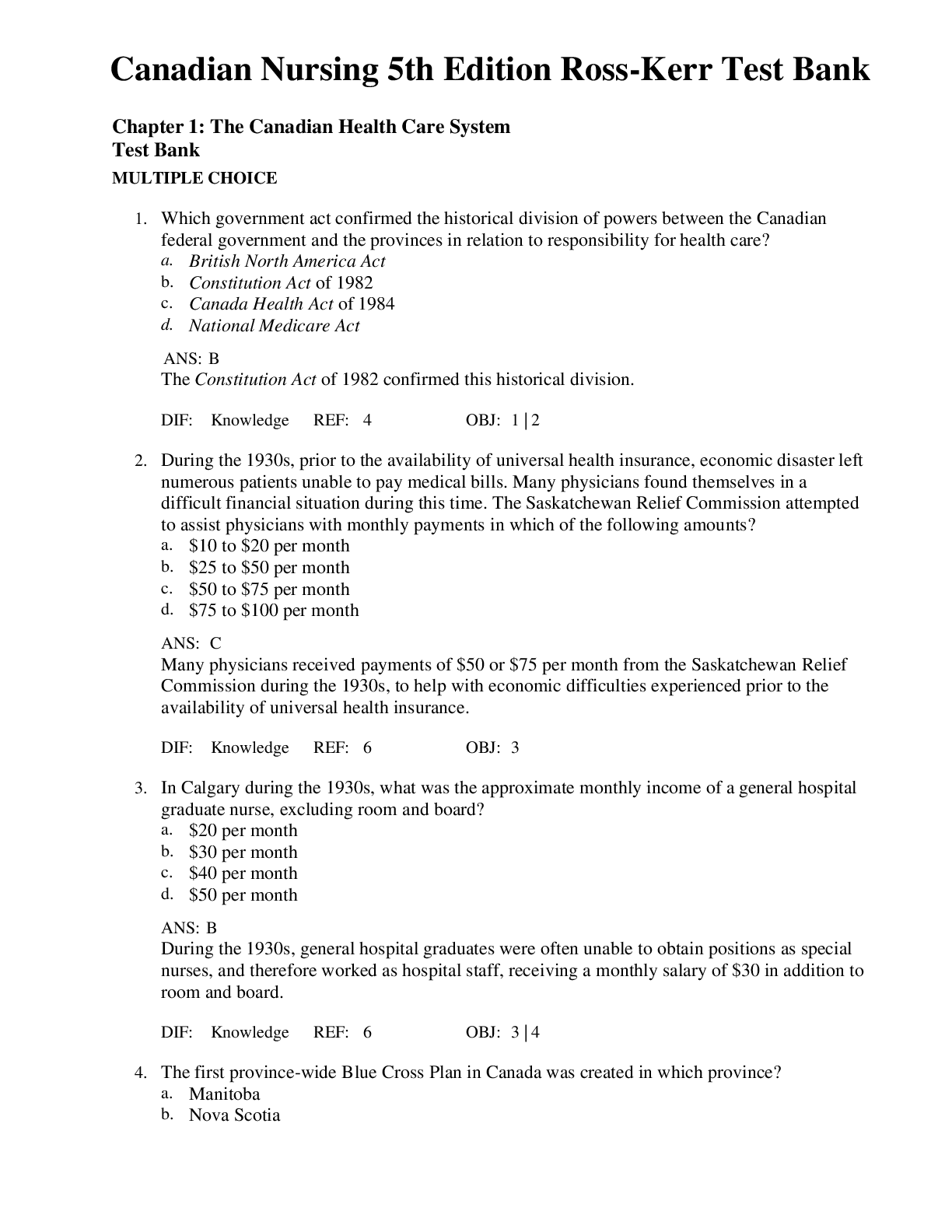
Test Bank for Canadian Nursing 5th Edition Ross-Kerr All Chapters
Test Bank for Canadian Nursing 5th Edition Ross-Kerr All Chapters Test Bank for Canadian Nursing 5th Edition Ross-Kerr All Chapters Test Bank for Canadian Nursing 5th Edition Ross-Kerr All Chapters Te...
By Gradexam , Uploaded: Mar 11, 2024
$20
*NURSING> TEST BANK > Test Bank for Gerontologic Nursing 5th Edition by Meiner All Chapters (All)
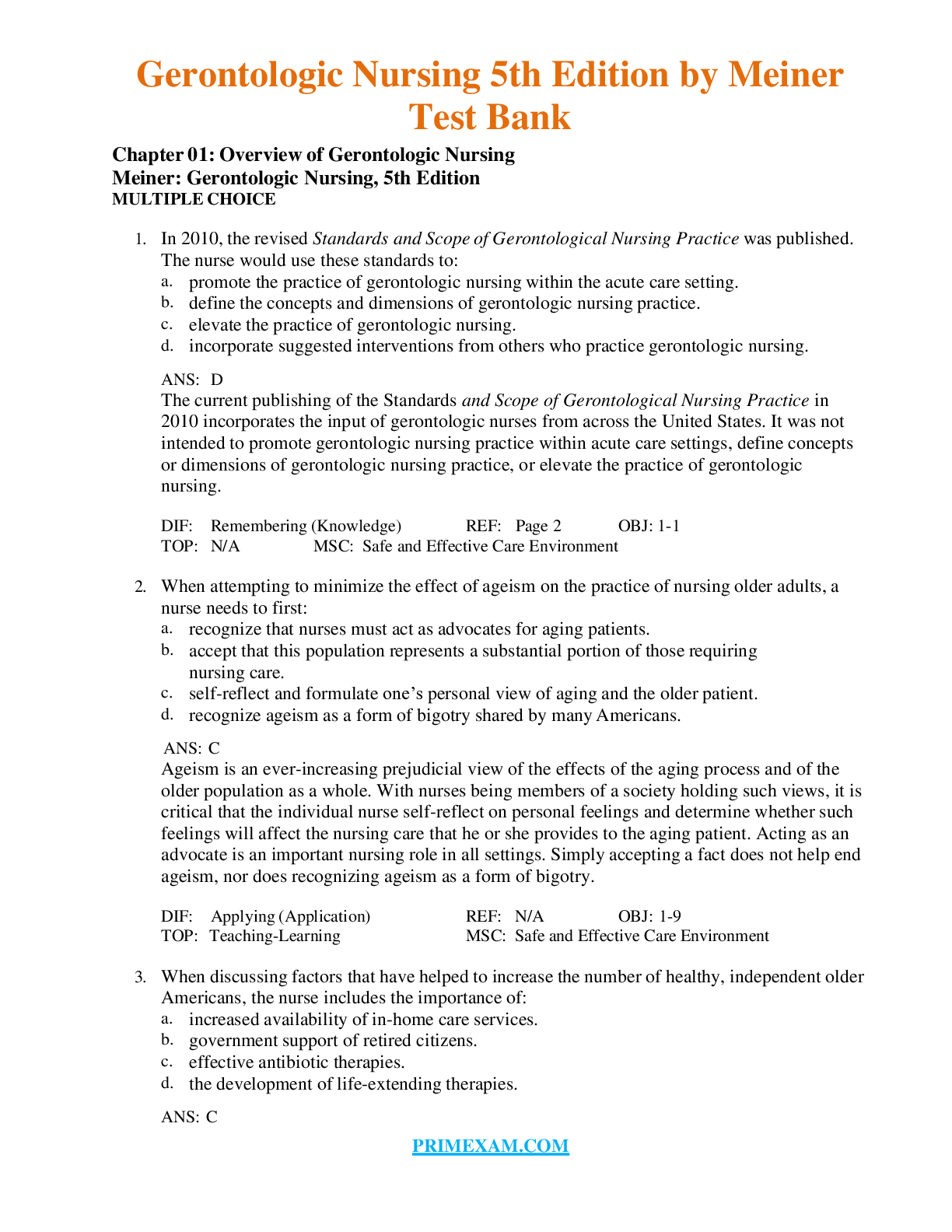
Test Bank for Gerontologic Nursing 5th Edition by Meiner All Chapters
Test Bank for Gerontologic Nursing 5th Edition by Meiner All ChaptersTest Bank for Gerontologic Nursing 5th Edition by Meiner All ChaptersTest Bank for Gerontologic Nursing 5th Edition by Meiner All C...
By Gradexam , Uploaded: Mar 11, 2024
$20
*NURSING> TEST BANK > Test Bank for deWits Fundamental Concepts and Skills for Nursing 5th Edition by Williams All Chapters (All)
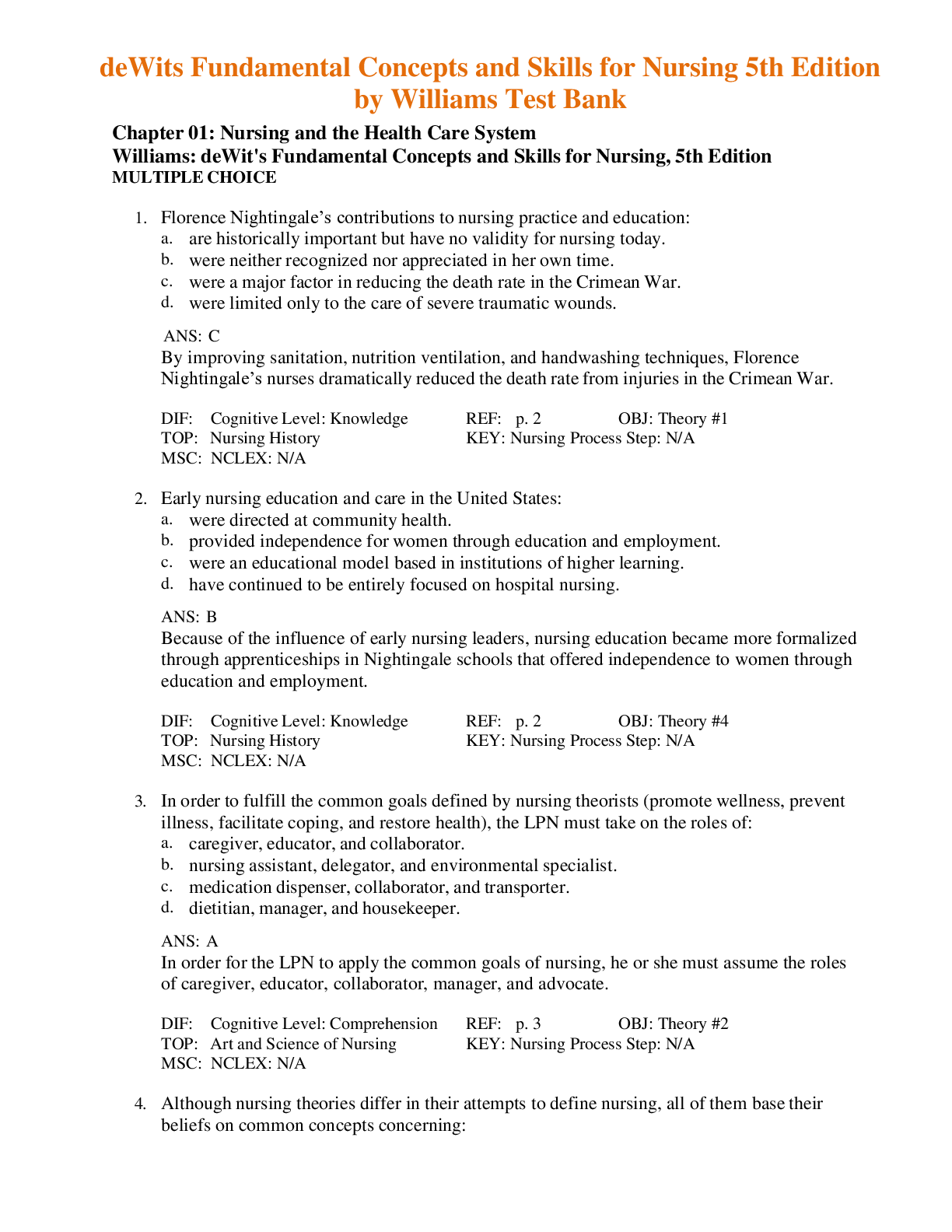
Test Bank for deWits Fundamental Concepts and Skills for Nursing 5th Edition by Williams All Chapters
Test Bank for deWits Fundamental Concepts and Skills for Nursing 5th Edition by Williams All Chapters Test Bank for deWits Fundamental Concepts and Skills for Nursing 5th Edition by Williams All Chapt...
By Gradexam , Uploaded: Mar 12, 2024
$20
*NURSING> TEST BANK > Test Bank for Essentials of Maternity Newborn & Women's Health Nursing 5th Edition Ricci All Chapters (All)
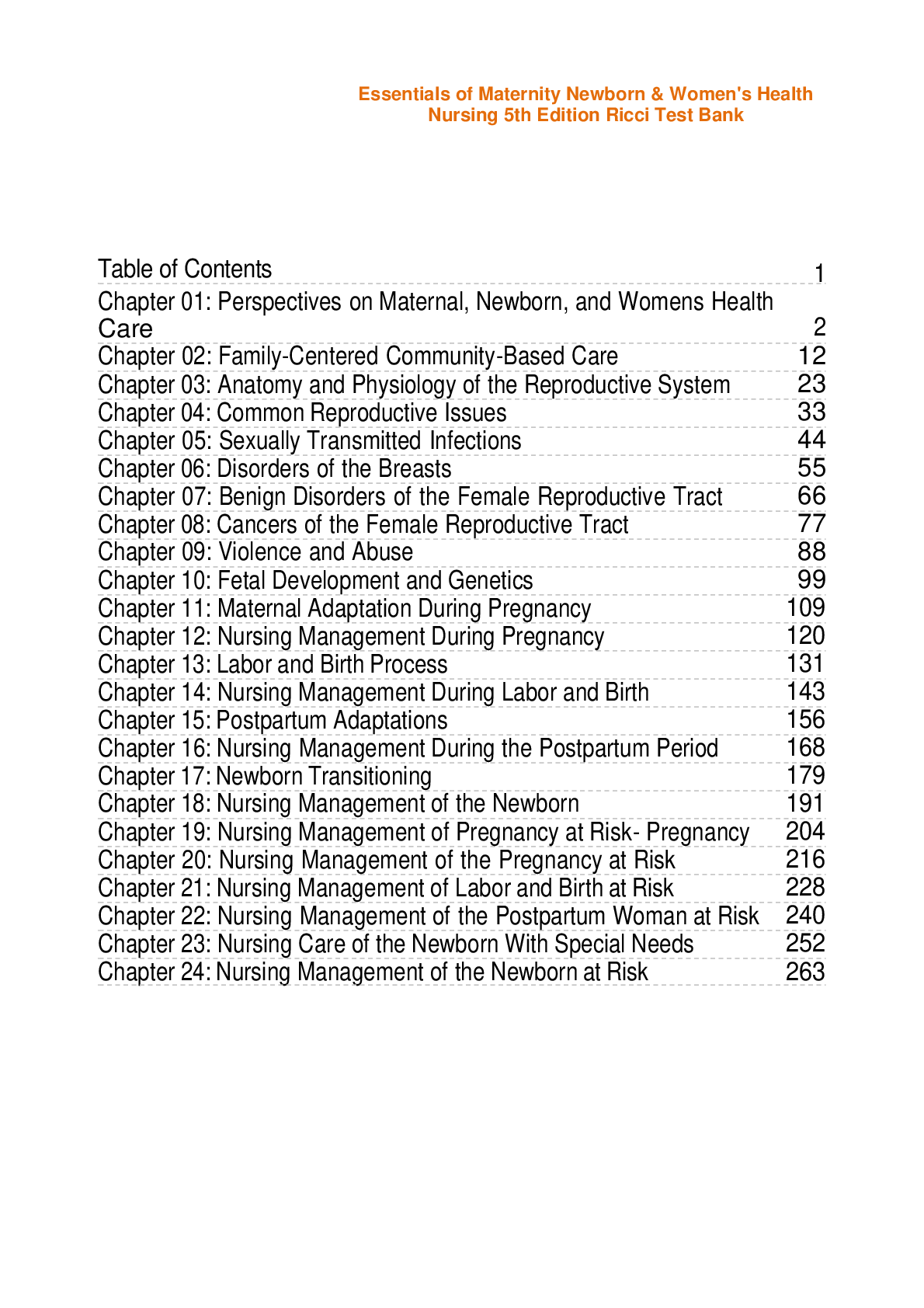
Test Bank for Essentials of Maternity Newborn & Women's Health Nursing 5th Edition Ricci All Chapters
Test Bank for Essentials of Maternity Newborn & Women's Health Nursing 5th Edition Ricci All ChaptersTest Bank for Essentials of Maternity Newborn & Women's Health Nursing 5th Edition Ricci All Chap...
By Gradexam , Uploaded: Mar 12, 2024
$20
*NURSING> TEST BANK > Test Bank for Foundations for Population Health in Community Public Health Nursing 5th Edition Stanhope All Chapters (All)
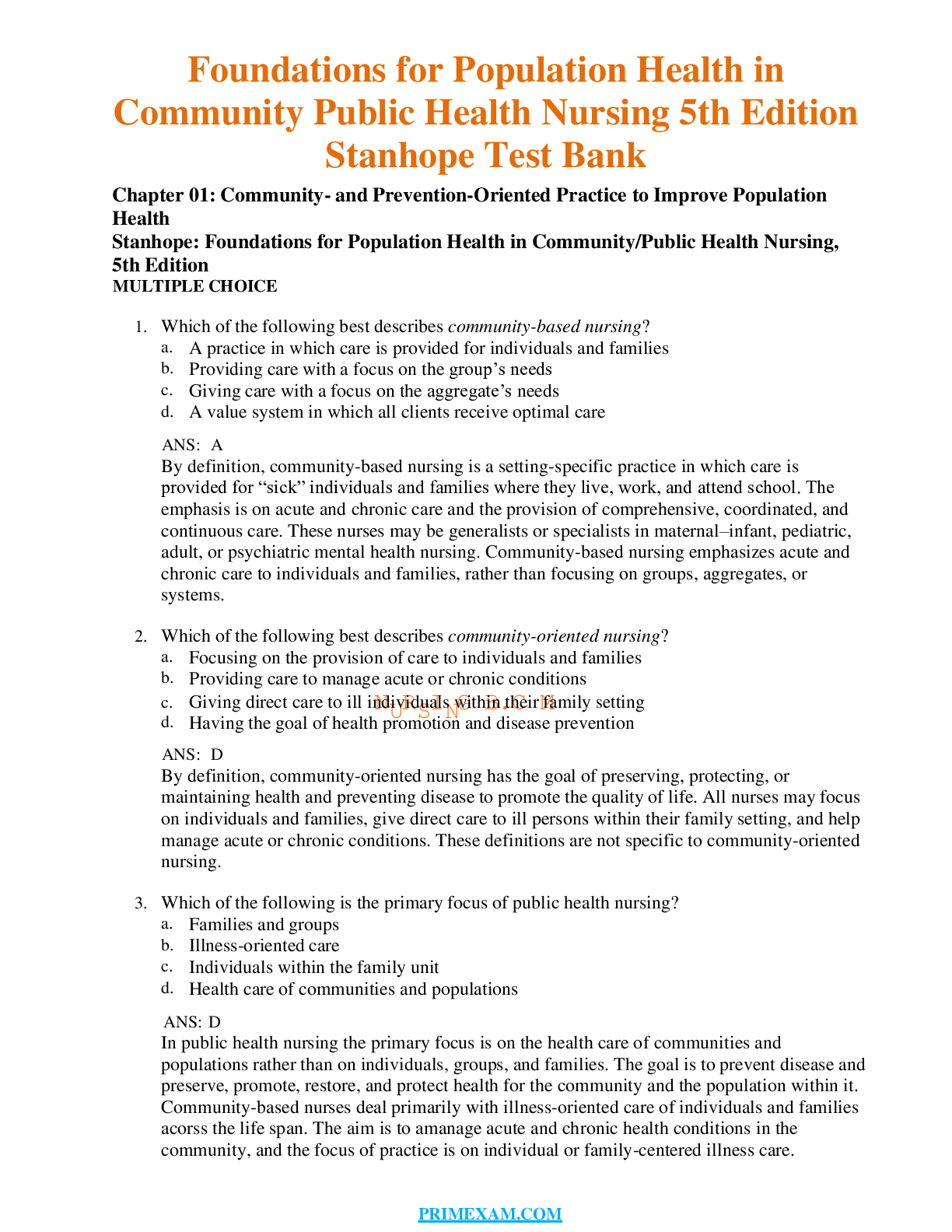
Test Bank for Foundations for Population Health in Community Public Health Nursing 5th Edition Stanhope All Chapters
Test Bank for Foundations for Population Health in Community Public Health Nursing 5th Edition Stanhope All ChaptersTest Bank for Foundations for Population Health in Community Public Health Nursing 5...
By Gradexam , Uploaded: Mar 12, 2024
$20
*NURSING> TEST BANK > Foundations for Population Health in Community Public Health Nursing 5th Edition Stanhope Test Bank (All)
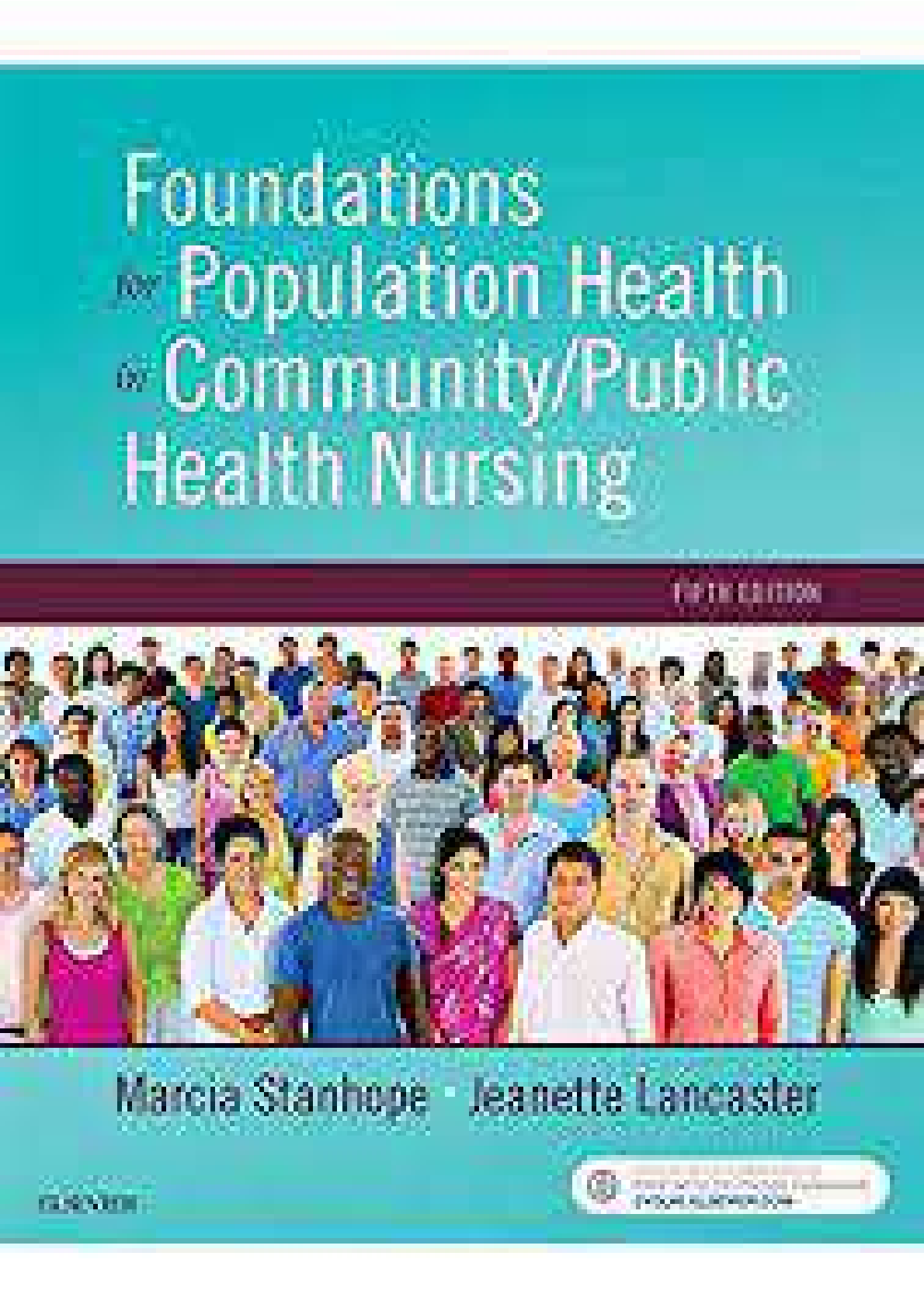
Foundations for Population Health in Community Public Health Nursing 5th Edition Stanhope Test Bank
Chapter 01: Community- and Prevention-Oriented Practice to Improve Population Health Stanhope: Foundations for Population Health in Community/Public Health Nursing, 5th Edition MULTIPLE CHOICE...
By TESTBANKSGURU , Uploaded: Mar 10, 2024
$19.5
Document information
Connected school, study & course
About the document
Uploaded On
Jan 29, 2021
Number of pages
609
Written in
Additional information
This document has been written for:
Uploaded
Jan 29, 2021
Downloads
2
Views
127





